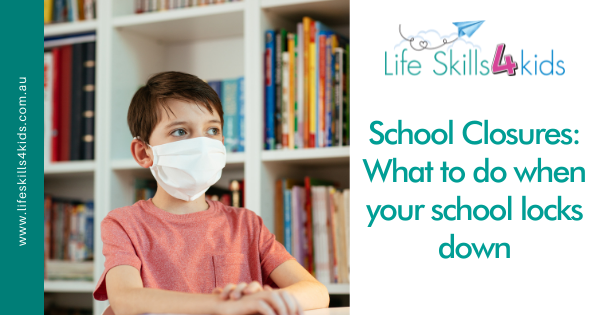The dreaded announcement … What should you do?
No one wants to hear that their child’s school has been closed because of positive Covid cases, and any parent who’s heard the dreaded announcement will be familiar with the sinking feeling that accompanies it.
First of all … breathe! You can get through this.
The other important thing to remember is that while Covid is serious for older people, children usually fare better if they do catch it and might only have mild symptoms and recover quickly. Just think of the best outcome, take a deep breath, and turn your attention to what you can do to get through this.
Be a sleuth
OK, sometimes it feels as if you need a degree in sleuthing to get to the bottom of government rules for school closures and other lockdowns! They can be confusing and change from one day to the next.
Read through the following checklist of questions you need to find answers for.
· What are the rules for isolation?
· Do I need to isolate along with my child?
· Does the whole family need to stay at home?
· Can my partner still go to work?
· Do I need to cancel or rearrange my work?
· Do I need to contact others we have been with to let them know?
Decide how to tell your child
Lots of kids suffer from anxiety with sudden changes of plan, so if this happens to your child, you’re not alone!
The best approach is to remain calm and be aware of your own anxiety levels. Take some time out to centre yourself if you need to. Then talk to your child about how plans change sometimes and this week will be a little different to usual.
Use a visual weekly planner
If your child is young, you can use a visual weekly planner to explain that there’s been a change of plan. Explain that school will be from home for at least one day, maybe more, and create a new plan for the week.
In your visual planner, you can paste pictures of what’s going to happen on each day of the week. If you don’t know yet, that’s OK. We have a strategy for that (see below). For older children, you might prefer to write in your planner instead of using pictures.
So, for example, if your isolation period begins on a Monday, get your child to choose a picture of a home to put in the planner. Now when anxiety strikes, your child can look at the planner and know that Monday will be spent at home.
For the next day, place a picture of a question mark on the planner with blu-tack. This means that you don’t know yet whether school is on. If you still don’t have information for the following day, move the question mark to the next day. This will help your child to understand that you are waiting for the information that will tell you whether school is back on.
Once you have a return date for school, place a picture of a school (or your child’s school) in the appropriate square.
This is a great strategy for anxious kids who can look at the planner to remind themselves about what is happening next.
Plan to succeed at home
Home isolation can be very trying with everyone falling over each other or experiencing negative feelings about being cooped up in the house.
But it doesn’t have to become a disaster, especially for a child experiencing anxiety.
One of the best ways to help your child feel secure is to create a plan for each day. Predictability and structure help children feel safe when the world around them is full of uncertainty.
So you can use the same strategies above for a daily planner. For younger children, use a visual daily planner that you can stick pictures in. With older children, you might prefer to write in the daily activities.
Your new home routine doesn’t have to be complex, and you need to allow some flexibility or it will become too difficult to stick with. But you should include the “milestones” or big events of the day such as bedtime, waking up, meal times, or the start and finish of school. You choose what’s important in your family.
You can do your plan for the entire day, or you can divide it up into morning and afternoon – whatever works best.
Beware of too much screen time
Don’t worry, we’ve all done it! Screen time is a handy babysitter when you’re trying to work at home or even when you just want some peace.
But in the longer term, too much is harmful to kids’ wellbeing. It can make bedtimes more difficult and increase social anxiety, among other things.
So the best thing is to aim for a balanced routine that includes exercise, time outdoors if possible, and time spent doing interactive activities with other members of the family.
You can do this!
You’ve got this! As some of you who have already been through it know, this too shall pass. Nothing lasts forever, and it’s just a matter of doing the best you can until schools reopen and you can resume your normal life again.
You’re doing an amazing job of holding it together under difficult circumstances, so give yourself a pat on the back, take a deep breath, and make sure you’re caring for yourself, too. You’ve got this!


